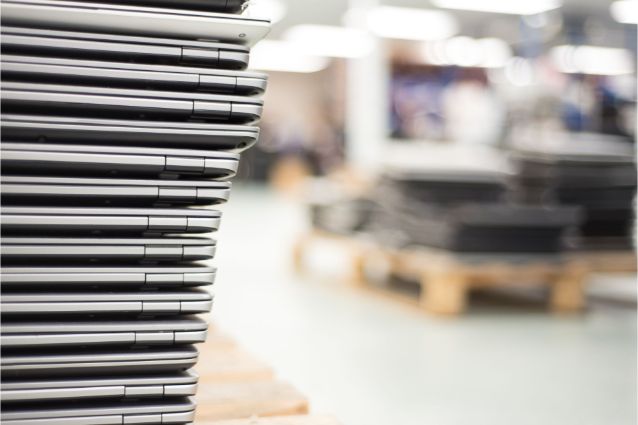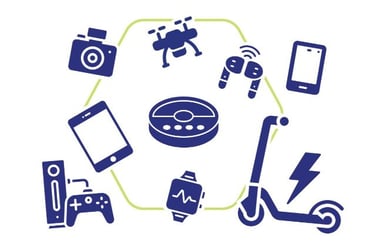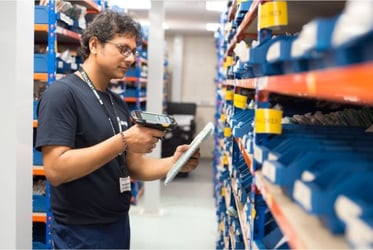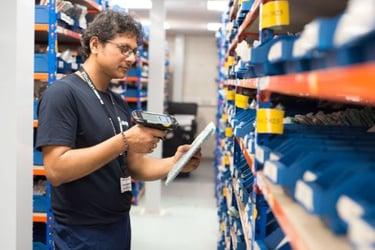Are you unsure which model suits your business, leasing or DaaS (Device as a Service)? Are you struggling to understand the differences and similarities between the two?
Ingram Micro Lifecycle has been working within the technology and IT industry helping OEMs, network operators, enterprises, and other customers with reverse logistics and lifecycle extension services for over a decade. We can see the genuine value that both the DaaS and leasing models offer and have begun supporting customers through these programs. The Ingram Micro Financial Solutions division supports customers with financing.
By the end of this piece, you’ll better understand how the two models are different and know which would best suit your organization.
Ownership versus subscription
Traditionally, the approach to using technology has been through ownership. You see the model you want, and you buy it outright. You forecast and plan your IT budgets based on predictions of staff usage.
Subscribing to products is not new. Think Netflix, Spotify, your mortgage, or rent. PCP (Personal Contract Purchase) for cars. Somebody owns that product, but you’re paying them to use it.
You may not want to buy the films or albums and maybe can’t afford to buy a house outright. A subscription-based model keeps the products accessible for those who don’t want to or can’t own them.
The global leasing market is growing, with the total market value expected to reach $2.4 trillion (£1.77 trillion) in 2026, increasing from $1.35 trillion in 2021.
Why subscribe, not buy?
Both DaaS and leasing involve an ongoing monthly payment for usage compared to an upfront cost for ownership. Rather than own the product, you pay a subscription fee to use it.
It’s like financing a car where there are three outcomes from your lease ending:
- Pay the higher monthly fee, and own it at the end
- Pay the lower monthly fee, and return the car for an upgrade/different model
- Pay the lower monthly fee plus a final balloon payment to own it
80% of US businesses prefer to lease their technology, presenting a great opportunity.
With technology subscription models, there are variances, which we’ll cover below.
Switches capex to opex
By owning the product, you have a capital expenditure (capex) cost on your balance sheet.
With a subscription model, this instead becomes an operational expenditure (opex) cost.
The former is a larger one-off fee, and the responsibility for the product is yours alone. The latter is a smaller ongoing fee, and the responsibility for the product belongs to someone else.
Efficient technology usage
When you own a product, you’re likely to use it for as long as needed. Between users, products can sit in storage, collecting dust, rather than being useful.
Residual sensitive information poses a data risk if not compliantly wiped between users. You’re responsible for the decommissioning and disposal of obsolete technology.
Leasing ensures your technology refreshes regularly and avoids becoming stagnant. You’ll also only be renting the devices you need rather than being lumbered with tech you no longer have a use for.
Similarities of DaaS and leasing
Aside from the above points of changing to an opex cost and sustainability, here are the other similarities between DaaS and leasing.
Obtaining stakeholder support
As the models involve a different approach from purchasing, you’d need to get approval from your stakeholders before making the move.
This would mean explaining the change and ensuring you have their support and understanding. Tackle any questions they have about the change in advance and aim to foresee any future snags that might arise.
Depending on your unique situation, this could be an advantage or disadvantage to switching.
Getting their support could add a time delay to making the change. Alternatively, it could be a straightforward process.
Developing new processes
A new way of working means developing a new process flow for your company.
You’ll need to understand the different possible outcomes and situations that could arise during your subscription to map how you and your staff should best approach each.
For example, what should happen at the end of the contract? How would you process collecting devices, particularly if you have remote or hybrid workers?
Again, this could be time-consuming, but it’s an efficient approach to making the change, which saves potential future complications.
It's important that activities are as system-driven as possible to enable maximized automation. For example, in reminders or notifications, but also to allow effective monitoring, tracking, and recording of pertinent actions.
Allow your processes to be agile as the company and its requirements change.
Breakages & replacements
If something goes wrong with an owned device, you need to have a plan for resolution.
A lease or DaaS contract removes some of the burden of device management.
Determine the level of support your contract includes and what issues it covers before settling on a supplier. You may be able to exchange a broken device for a replacement.
An efficient DaaS partner can replace a faulty or damaged device in under 24 hours. A fully configured replacement could be shipped immediately along with sustainable returns packaging for the faulty device.
The differences lay in ongoing technical support – see the differences section.
Upgrades
Leasing models prompt you to refresh your technology at regular intervals. If you had purchased the technology, you’ll perhaps be left with aging equipment until it breaks or becomes unsupported.
At the end of your contract period, you can hand the devices back, and you have the choice to swap to newer models. If you’re happy with the devices you’ve got, you can refresh the contract rather than the products.
You can also negotiate the ability to upgrade devices during the contracted period if this is something you want to offer your users.
Forecasting
With the switch to a monthly fee and a dedicated end to your contract, you can manage your finances tightly.
You’ll know what your monthly outgoings are and when you’ll face a change in contract when it comes time to renew.
The difference in financial costs associated with your technology will be for lifecycle services.
Sustainability & circularity
When renting equipment, the burden of decommissioning equipment compliantly is taken from you. The providers are responsible for instigating end-of-life processing when it becomes time.
You enable a circular economy as you hand back the device when you no longer need it, and the partner will repair and refurbish it ahead of going back out to another user.
The lifecycle is prolonged for as long as possible, rather than the product sitting unused or heading to landfill.
These are financially and environmentally sustainable options, as you only pay for the technology as (and when) you need it, and ensure the device lifecycle is maximized.
Differences between DaaS and leasing
Although the term ‘leasing’ can be used synonymously, some key differences exist between leasing contracts and contracts operating under Device as a Service.
Troubleshooting and support
You’re responsible for any ongoing technical issues and support for the duration of your leasing contract. Under a DaaS agreement, lifecycle services are provided.
- Leasing: You either need to pay a third-party IT support agency to provide assistance when something fails, or it becomes the responsibility of your internal IT team to manage.
If you have a small team then this could be a bigger issue, especially as their skills and experience will need to be aligned with the products you’re leasing. The extra outlay is something you’ll have to plan for and accommodate in your forecasting. - DaaS: The company your contract is with will provide support to get you back up and running. This eases the burden on your IT team so they can spend more time on strategic activities rather than firefighting.
Pre-configurations vs out of the box
Leasing products will come to you straight from the box, with no bells and whistles.
There’s a bit more flexibility with DaaS, depending on your partner. You can create a list of requirements that your devices must meet.
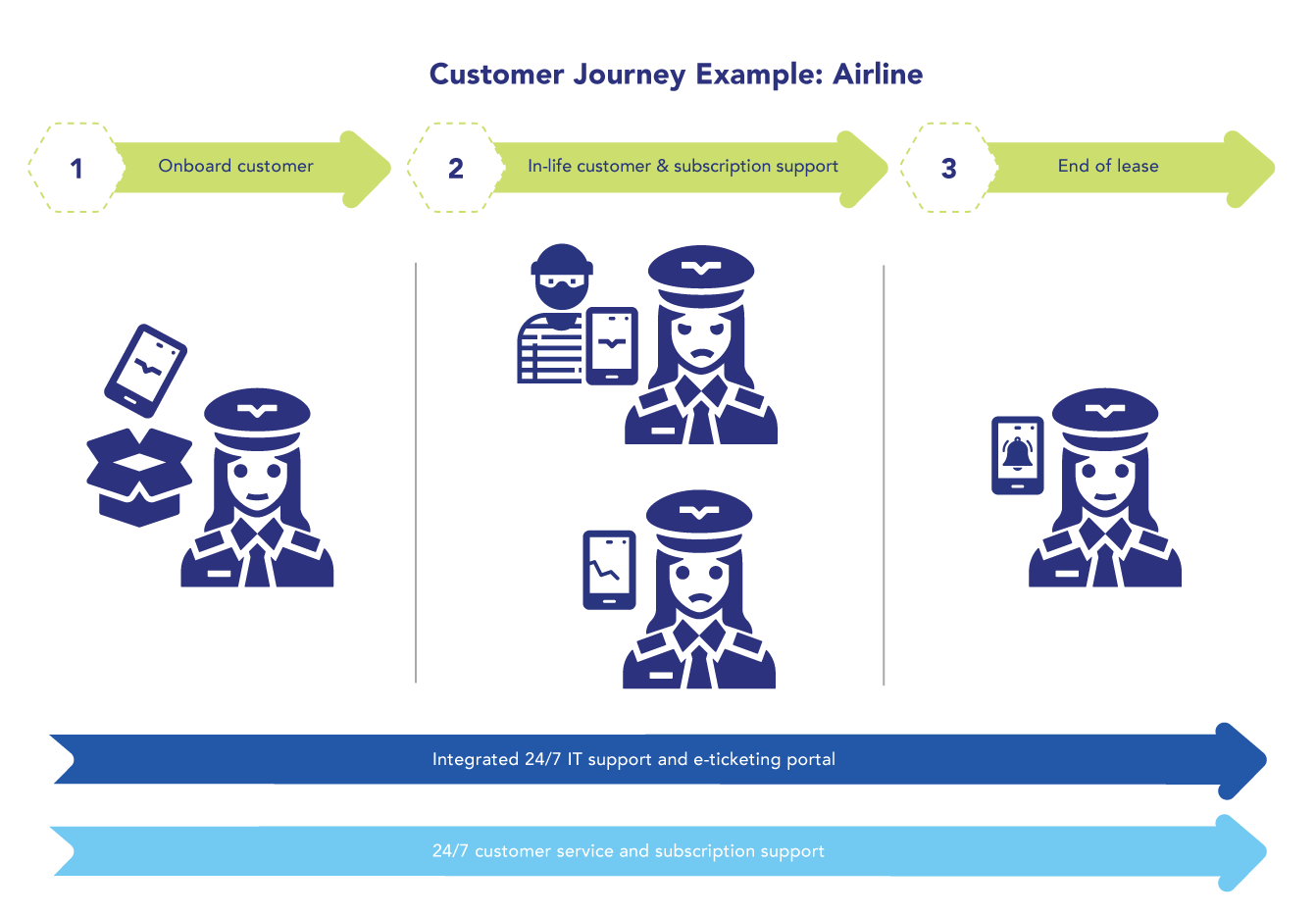
In this example, the airline has specified that devices must be delivered to its staff with the camera disabled, a screen protector fitted, and their branded wallpaper preloaded onto the display.
Option to own
Leasing sometimes has the option to make higher monthly payments to purchase the device. Alternatively, there may be smaller monthly payments with a final balloon payment to allow you to own the product outright once the contract is over.
There is no option to eventually own products when used through Device as a Service.
Releasing time from your IT team
The impact on your IT team will vary depending on whether you choose leasing or DaaS. We mentioned above that DaaS includes lifecycle management so that doesn’t become the responsibility of your IT team.
The secondary way in which their time will be released is via asset tracking. This is particularly important if you have remote or hybrid staff. Your DaaS provider will track the assets as opposed to your IT team. If you were leasing equipment, it would be your responsibility to track it.
When products are recalled, either because of an issue or the contract ends, your IT team would need to organize the devices. However, a DaaS partner would do this for you.
DaaS is packaged with a system that fully integrates into your current processes. You, your customers, and/or employees can manage their devices, have full visibility, and can trigger actions. These include reporting faulty devices, losses, or thefts. Businesses can also seamlessly manage the end-of-lease process.
Products through DaaS have fewer implications for your IT staff so they are free to work on proactive projects, rather than work reactively.
Device quantities
This largely depends on the contract rather than the specific model. Some will allow you to increase or decrease the volume of devices you’re leasing during your contract. There’ll be a pre-agreed percentage of leeway outlined so you can increase or decrease your fleet.
This ensures you’re not paying for devices that you’re not using, and gives you the agility to upscale if your team grows.
A leasing contract will only let you change volumes at the end of the contract when you renegotiate.
Which works best for you?
To summarize, the key differences between the leasing and Device as a Service models are:
.jpg?width=1079&height=1079&name=infographic-leasing-vs-daas-for-business%20(reduced%20size).jpg)
If you’re ready to switch from a purchasing model to a subscription-based one for your technology assets, reach out to our team of experts today to discuss the options. We’re happy to discuss what solution would be the best fit for you and your business.
Our sister division, Ingram Micro Financial Solutions, is also on-hand with a package of financial services.
Related articles:
- Parallel service provisions to consider for leasing/DaaS
- What is configuration and fulfilment?
- 9 benefits of switching to a DaaS model
- How a technology device as a service solution works
- The rise of Device as a Service: why we’re renting technology
- 4 ways a circular economy has influenced device ownership
- 6 reasons why subscription models are on the rise
- Benefits of a B2B partner supporting B2C operations







